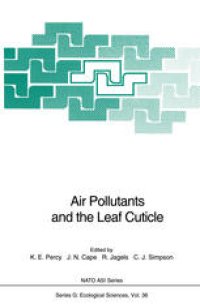
Ebook: Air Pollutants and the Leaf Cuticle
Author: Peter J. Holloway (auth.) Kevin E. Percy J. Neil Cape Richard Jagels Caroline J. Simpson (eds.)
- Tags: Ecology, Ecotoxicology, Plant Sciences, Atmospheric Protection/Air Quality Control/Air Pollution, Agriculture, Forestry
- Series: NATO ASI Series 36
- Year: 1994
- Publisher: Springer-Verlag Berlin Heidelberg
- Edition: 1
- Language: English
- pdf
Plant leaves are covered by a thin, lipoidal, non-living membrane called the cuticle. Forming the interface between plants and the atmospheric environment, it presents an effective barrier to pollutant entry.
The book provides a comprehensive review of air pollutant effects on the cuticle and covers the following thematic areas: - Cuticular physicochemical characteristics, physiological, regulatory, and protective roles. - Effects, mechanisms, and consequences of air pollutant interaction with leaf cuticles. - Non-anthropogenic and environmental influences on the cuticle and potential of the cuticle for biomonitoring and critical levels mapping. - New developments in experimental methodology and analytical techniques.
Plant leaves are covered by a thin, lipoidal, non-living membrane called the cuticle. Forming the interface between plants and the atmospheric environment, it presents an effective barrier to pollutant entry.
The book provides a comprehensive review of air pollutant effects on the cuticle and covers the following thematic areas: - Cuticular physicochemical characteristics, physiological, regulatory, and protective roles. - Effects, mechanisms, and consequences of air pollutant interaction with leaf cuticles. - Non-anthropogenic and environmental influences on the cuticle and potential of the cuticle for biomonitoring and critical levels mapping. - New developments in experimental methodology and analytical techniques.
Plant leaves are covered by a thin, lipoidal, non-living membrane called the cuticle. Forming the interface between plants and the atmospheric environment, it presents an effective barrier to pollutant entry.
The book provides a comprehensive review of air pollutant effects on the cuticle and covers the following thematic areas: - Cuticular physicochemical characteristics, physiological, regulatory, and protective roles. - Effects, mechanisms, and consequences of air pollutant interaction with leaf cuticles. - Non-anthropogenic and environmental influences on the cuticle and potential of the cuticle for biomonitoring and critical levels mapping. - New developments in experimental methodology and analytical techniques.
Content:
Front Matter....Pages I-IX
Front Matter....Pages 1-1
Plant Cuticles: Physicochemical Characteristics and Biosynthesis....Pages 1-13
Modelling Pollutant Deposition to Vegetation: Scaling Down from the Canopy to the Biochemical Level....Pages 15-37
Air Pollutants and Plant Cuticles: Mechanisms of Gas and Water Transport, and Effects on Water Permeability....Pages 39-53
Ion Transport Across Leaf Cuticles: Concepts and Mechanisms....Pages 55-65
Effects of Air Pollutants on Epicuticular Wax Chemical Composition....Pages 67-79
Effects of Air Pollutants on Epicuticular Wax Structure....Pages 81-96
Leaf Wettability as a Measure of Air Pollution Effects....Pages 97-105
Air Pollutants and the Cuticle: Implications for Plant Physiology....Pages 107-111
Cuticular Characteristics in the Detection of Plant Stress Due to Air Pollution — New Problems in the Use of these Cuticular Characteristics....Pages 113-122
Evaluation of Pollutant Critical Levels from Leaf Surface Characteristics....Pages 123-138
New Analytical Techniques for Cuticle Chemical Analysis....Pages 139-147
Leaf Cuticles as Mediators of Environmental Influences: New Developments in the Use of Isolated Cuticles....Pages 149-163
Front Matter....Pages 165-165
The Effect of the Environment on the Structure, Quantity and Composition of Spruce Needle Wax....Pages 165-174
Effect of Ozone and Elevated Carbon Dioxide on Cuticular Membrane Ultrastructure of Yellow Poplar (Liriodendron tulipifera)....Pages 175-182
Spatial Distribution of Sulphate Uptake by Wind-Damaged Beech Leaves....Pages 183-193
Effects of UV-B Radiation on Wax Biosynthesis....Pages 195-204
Effects of Acid Rain and Surfactant Pollution on the Foliar Structure of Some Tree Species....Pages 205-216
Fourier Transform IR Studies on the Interaction of Selected Chemicals with Isolated Cuticles....Pages 217-223
Effects of Wind and Simulated Acid Mist on Leaf Cuticles....Pages 225-237
Measurements and Modelling of Ozone Deposition to Wet Foliage....Pages 239-253
Front Matter....Pages 255-255
The Effect of Age, Canopy Position and Elevation on Foliar Wettability of Picea rubens and Abies balsamea: Implications for Pollutant-Induced Epicuticular Wax Degradation....Pages 255-260
Effect of Elevation and Foliar Age on Maximum Leaf Resistance to Water Vapor Diffusion in Conifers of the Central Rocky Mountains, U.S.A.....Pages 261-268
Preliminary Observations on the Influence of Increasing Atmospheric CO2 Levels on Cuticular Waxes of Spruce Needles....Pages 269-276
Effects of Ozone Exposures on Epicuticular Wax of Ponderosa Pine Needles....Pages 277-286
Observations on the Effects of Acid Rain Treatment on Needle Surfaces of Scots Pine and Norway Spruce Seedlings....Pages 287-294
Problems in Interpreting Effects of Air Pollutants on Spruce Epicuticular Waxes....Pages 295-304
Recent Advances Using Electron Beam Analysis to Detect Cuticular Changes Induced by Air Pollution....Pages 305-314
Physico-Chemical Characteristics of Pine Needle Surfaces Exposed to Different Air Pollution Sources....Pages 315-319
A Comparison of Epicuticular Wax of Pinus sylvestris Needles from Three Sites in Ireland....Pages 321-327
Characteristics and Geographical Distribution of the Changes in Scots Pine Needle Surfaces in Finnish Lapland and the Kola Peninsula....Pages 329-339
Forest Health Monitoring by the Canadian Forest Service: Now and the Future....Pages 341-349
Front Matter....Pages 351-358
Session 1....Pages 359-369
Session 2....Pages 371-376
Session 3....Pages 377-377
Session 4....Pages 377-378
Session 5....Pages 379-379
Session 6....Pages 381-381
Back Matter....Pages 383-383
Recommendations by Participants....Pages 385-385
....Pages 387-388
Download the book Air Pollutants and the Leaf Cuticle for free or read online
Continue reading on any device:

Last viewed books
Related books
{related-news}
Comments (0)